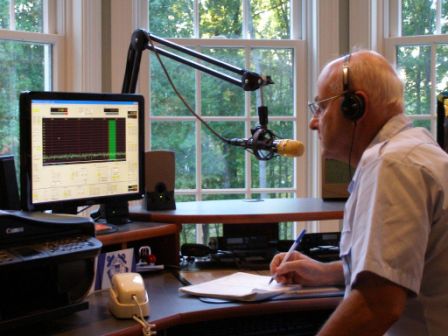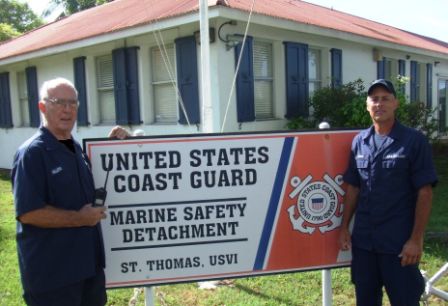

A Brush with Hurricane “Earl”
Article by Joe T. O’Hagan, Branch Chief for Qualification and Training, Telecommunications Division, National Response Department (BC-RTQ)
 |
|
Dan Amoroso performing his Auxiliary Monitor mission at his home in Media, PA. Dan is also a member of the National Response, Telecommunications staff. |
As Hurricane Earl recently made its way to the United States over the Caribbean Sea packing extreme winds and seas of a category four event, the Coast Guard and Auxiliary prepared for the worst and hoped for the best. While “Earl” was not a direct hit, it did brush the Caribbean Islands and the mainland’s east coast.
To ensure communications during this event, the Coast Guard moved their Communications Area Master Station – Atlantic inland. Subsequently the Auxiliary Monitoring system was tasked to actively monitor public broadcasts in support of the Global Maritime Distress & Safety System. An additional task was issued to the Pacific Area Auxiliary Monitors to monitor several additional frequencies. At this point, many Auxiliary telecommunications operators nationwide were involved in support of the Coast Guard as Hurricane Earl moved in for its close encounter with the east coast of the mainland.
While there were many cases of Auxiliary telecommunications operators processing distress calls, there were two incidents that illustrate their action and devotion to duty.
One of the first United States possessions to feel the effect of Hurricane Earl was St. Thomas in the Caribbean. On Sunday 29 August, “Earl” bore down on the island and disabled the Coast Guard’s tower back-up generator.
 |
|
Auxiliarists Klaus Willems and John Melluci.” Photo by LTCDR Daniel Buchsbaum, Supervisor, US Coast Guard Marine Safety Detachment, St Thomas, VI |
CG Sector San Juan contacted Auxiliary Monitors Klaus Willems, Cheryl Boynes Jackson, and John Melucci asking them to monitor the Very High Frequency (VHF) radio for any distress calls. As the eye of Earl passed St. Thomas, late in the evening on Monday 30 August, Sector San Juan contacted Auxiliarist Willems regarding a sailing vessel aground on the north side of Water Island.
Auxiliarist Willems was able to contact the vessel owner by radio and cellular phone, advising all to stay aboard since the vessel was very close to shore. Sector San Juan was continuously advised of the situation via land-line. The strong winds subsided around an hour later and a near by vessel was able to assist the grounded vessel. It was not until Tuesday 31 August that the Auxiliary team was able to stand down. Theirs is a great example of telecommunications skill, devotion to duty, and professional action while supporting the Coast Guard and the boating public.
The second example involved Auxiliarist Dan Amoroso monitoring the high frequency band from his home in Media Pennsylvania. Late in the evening of Thursday, 2 September, Amoroso received a distress call. Dan’s communications system disclosed the identity of the vessel in distress, time of the call and its position.
Auxiliarist Amoroso immediately notified the personnel at the Communications Area Master Station – Atlantic of the situation and provided the information received from the distress call. An interesting twist to the story is that the vessel was located on the Mississippi River, just south of New Orleans and Auxiliarist Amoroso’s radio is in Pennsylvania, just outside of Philadelphia. This intercept again demonstrates the effectiveness of the Auxiliary Monitor program and the dedication of our members who serve on both coasts.
While the two stories outlined above took place during Hurricane Earl, there are numerous examples of members of our Auxiliary telecommunications community who stand watch during more routine times. Hurricane or no hurricane, we should salute all of our Auxiliary Telecommunication professionals and their dedication to the protection of life at sea.
~GJA 10/08/10